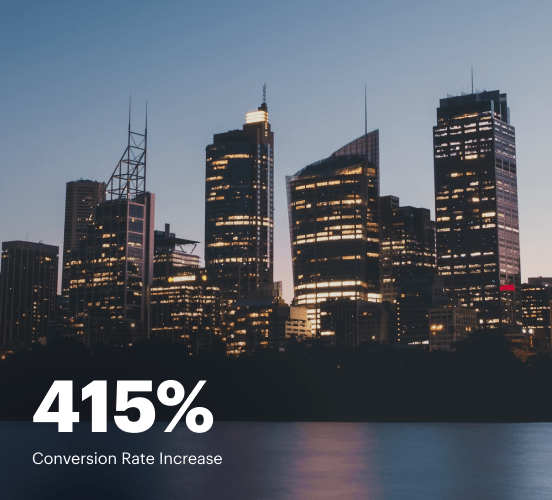How Emma vs. Drupal vs. Instapage stack up against each other
Compare Instapage with Emma and Drupal to create high-converting landing pages. With personalization, optimization, and collaboration tools, Instapage helps you deliver experiences that drive results.
Get startedSee how Instapage stacks up against the competition
| Feature | Instapage | Other builders |
| Drag-and-Drop Tools | ||
| Conversion-optimized templates | ||
| Manual and AI-powered A/B Tests | ||
| AI content suggestions | ||
| Popups and sticky bars | ||
| Canvas and grid blocks | ||
| Reusable and global elements | ||
| Form and popup builders | ||
| Built-in Heatmaps | ||
| Central analytics dashboard | ||
| Ad-to-page personalization and collections | ||
| Contacts, lists, and email | ||
| Dedicated, full-service CRO experts | ||
| Enterprise-ready platform |
Leading the way in building high-performing landing pages





Why Instapage is the smarter choice for your campaigns
Get everything you need to build, scale, and optimize high-converting landing pages—without coding.

Easier page building without coding
Instapage offers a flexible and seamless page creation experience with a library of 500+ conversion-focused layouts, Instablocks®, a drag-and-drop builder, and AI content generation. With technologies like Thor Render Engine®, you can create on-brand, mobile-responsive landing pages that load quickly and start converting during initial visitor clicks.

More insights — better results
Instapage lets you see in detail how each landing page experience and variation is performing so you can make targeted changes that boost page conversions. Use heatmaps for a better understanding of on-page activities, run A/B tests and AI-assisted experiments, and then track and evaluate results within robust analytics dashboards.

More personalized experiences
Instapage lets you quickly create high-performing landing pages tailored to each of your ad campaigns. Deliver personalized experiences for distinct audiences using dynamic text replacement. Effortlessly align specific advertisements to unique pages with AdMaps. Monitor audience-level metrics using our advanced data tools.

Built-in collaboration
Instapage collaboration capabilities bring your entire team together to speed up the process of landing page review, approval, and launch. No more frustrating and unnecessary revisions or edits scattered across emails. Provide instant feedback, conduct real-time page edits, and securely share your pages with outside stakeholders.

Free up time for your business
Invest time into business growth, not busy work. Launch landing pages faster with reusable forms and templates. Build once, reuse forever.
Explore all integrations






Easier page building without coding
Instapage offers a flexible and seamless page creation experience with a library of 500+ conversion-focused layouts, Instablocks®, a drag-and-drop builder, and AI content generation. With technologies like Thor Render Engine®, you can create on-brand, mobile-responsive landing pages that load quickly and start converting during initial visitor clicks.
More insights — better results
Instapage lets you see in detail how each landing page experience and variation is performing so you can make targeted changes that boost page conversions. Use heatmaps for a better understanding of on-page activities, run A/B tests and AI-assisted experiments, and then track and evaluate results within robust analytics dashboards.
More personalized experiences
Instapage lets you quickly create high-performing landing pages tailored to each of your ad campaigns. Deliver personalized experiences for distinct audiences using dynamic text replacement. Effortlessly align specific advertisements to unique pages with AdMaps. Monitor audience-level metrics using our advanced data tools.
Built-in collaboration
Instapage collaboration capabilities bring your entire team together to speed up the process of landing page review, approval, and launch. No more frustrating and unnecessary revisions or edits scattered across emails. Provide instant feedback, conduct real-time page edits, and securely share your pages with outside stakeholders.
Free up time for your business
Invest time into business growth, not busy work. Launch landing pages faster with reusable forms and templates. Build once, reuse forever.
Explore all integrationsGet started with Instapage in a few steps
-
Create your Instapage account
Start with Instapage by signing up via Google or your email. You'll get access to a free 14-day trial to discover Instapage capabilities. Feel free to cancel anytime during the 14-day trial if you decide that our product is not suitable for your business. -
Build and personalize your page
Create your first landing page from scratch or choose a template from 500+ customizable layouts. Use the drag-and-drop builder to add page elements, fonts, and backgrounds, refine content with AI, or add custom HTML, Javascript, and CSS. -
Review and make edits
Collaborate on page designs and streamline review processes. Invite your team members and stakeholders to review, edit, and provide feedback on your landing page. Collaborate knowing your page is confidential and only accessible to authorized users. -
Publish and track page performance
Publish your page to a domain or custom URL. Connect your pages to the ads you've created and track page performance within the analytics dashboard, run A/B tests and AI experiments, analyze results, and continuously optimize your landing page to maintain high conversions.
Instapage, Emma, and Drupal: The Ultimate Showdown
Choosing the right landing page builder is akin to selecting the perfect cast for a blockbuster movie — each contender brings its unique flair and strengths to the table. In this showdown, we’ll explore how Instapage, Emma, and Drupal stack up against each other in the realm of digital marketing. As we journey through each platform's features, performance, usability, and support, we'll discover which hero stands tall. By the end, not only will you be well-informed, but you might just feel inspired to give this marketing endeavor a shot yourself. (min:200 words)
Meet the Competitors Ready to Compete
In the competitive landscape of landing page builders, Instapage, Emma, and Drupal emerge as formidable players. Each has carved its niche: Instapage is revered for its powerful optimization tools, Emma charms users with its email marketing prowess, while Drupal offers a robust content management system designed for flexibility and customization. As these three platforms enter the ring, it’s essential to highlight what sets them apart and how they can each serve the marketing needs of diverse businesses. Whether you’re an eCommerce entrepreneur or a brand manager, understanding their offerings can empower you to make an informed decision. (min:200 words)
Round One - Feature Face-off
Template Variety and User Convenience Compared
When evaluating landing page builders, template variety and ease of use are paramount. Instapage features over 500 customizable templates, allowing marketers to craft polished, conversion-optimized pages. Emma, while primarily an email marketing tool, offers landing pages that can be seamlessly integrated with email campaigns. Drupal, on the other hand, provides an extensive range of templates but requires a more hands-on approach to customization. Thus, while Instapage shines in user-friendliness, comparing it to Emma and Drupal showcases how different approaches cater to varying marketing strategies. (min:200 words)
Instapage: A Trailblazer in Customization and Conversion Tools
Instapage doesn’t just promise customization; it delivers a full suite of features designed to boost conversion rates significantly. With A/B testing, heatmaps, and an intuitive drag-and-drop editor, Instapage stands out as a go-to partner for marketers seeking efficiency and effectiveness. The platform enables users to create highly relevant landing page experiences tailored to different audience segments. Plus, its seamless integration with numerous marketing tools ensures that every campaign can optimize conversions while minimizing costs. By putting marketers in the driver's seat, Instapage cultivates brand trust and customer loyalty through attentive, relevant experiences. (min:200 words)
Round Two - Speed and Efficiency Showdown
Speed is critical in the world of online marketing; a minor delay in loading time can lead to lost conversions. Think of it like waiting for your favorite song to start playing — a hindrance that distracts from the overall experience. In this round, we’ll explore how these three platforms compare in terms of performance, as well as how their speeds impact user engagement and conversion rates.
Advantages of Instapage in Speed and Efficiency:
- Optimized templates ensure quick loading times, improving user experience.
- CDN integration helps to deliver faster content regardless of user location.
- Automated performance enhancements reduce downtime and load speeds.
- Regular updates and maintenance keep the platform running smoothly.
Advantages of Emma in Speed and Efficiency:
- Simple landing page designs load quickly due to minimal bloat.
- Optimized for mobile responsiveness, enhancing user experience.
- Integration with email campaigns ensures fast content delivery.
Advantages of Drupal in Speed and Efficiency:
- Highly customizable caching options for faster load times.
- Scalability allows for compliance with high traffic in real-time.
- Optimization through low-code modules to streamline performance.
- Performance monitoring tools help in identifying speed bottlenecks.
In summary, while all three platforms demonstrate commendable speed and efficiency, Instapage takes the cake for its tailored approach to landing page performance. By prioritizing quick loading times and ensuring optimized user experiences, Instapage solidifies itself as a leader in the efficiency department.
Round Three - User Friendliness and Learning Curve Appeal
Navigating a new platform can feel daunting, but all three contenders offer unparalleled support for both beginner and seasoned marketers. Instapage, with its smooth onboarding process, fosters quick adoption without overwhelming users. Emma provides intuitive tools that streamline landing page creation, while Drupal, though a bit more complex, grants organizational strength and flexibility for advanced users. Each platform shows a commitment to ensuring that any user—regardless of skill level—can find their way quickly and confidently. (min:200 words)
Round Four - Support That Goes the Extra Mile
When technical difficulties arise, having a reliable support team is essential. Instapage prides itself on its customer service, providing chat support, detailed help articles, and live webinars. Emma also offers stellar support with email assistance and educational resources, ensuring users can get help when needed. Drupal, while community-driven, boasts an extensive knowledge base and forums where users can connect and support each other in navigating more complex queries. Across the board, these platforms display a commitment to keeping their users assisted and informed. (min:200 words)
Round Five - Pricing Insights and Value Examination
Understanding the pricing structures can make or break a decision. Instapage operates on a subscription model, providing different tiers based on features required, catering to various business sizes. Emma also follows a subscription model that aligns its pricing with email marketing features. Drupal is open-source and free but requires additional budgeting for hosting and potential development costs. All three platforms offer value based on user needs—it’s essential to assess what’s best for your specific goals. (min:200 words)
In conclusion, while Instapage, Emma, and Drupal each boasts unique strengths, the right choice ultimately hinges on your specific marketing needs. Whether it's a focus on customization, performance, or budget, evaluating these factors will lead you toward the best fit. Take Instapage for a spin with their free trial, and experience firsthand how it can empower your marketing strategies by reducing costs, boosting conversions, and enhancing customer trust. (min:200 words)










